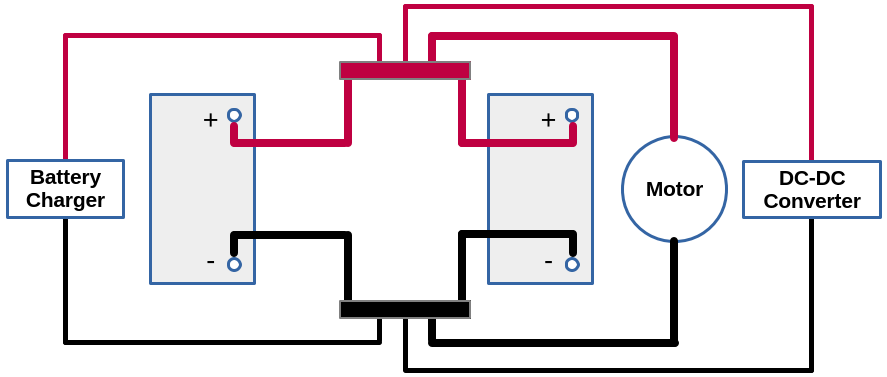Upgrades
Lithium Batteries
Upgrading from flooded lead-acid batteries to lithium batteries has many advantages.
Considerations
There are several ways to implement this upgrade. Things to consider are:
- LiFePO4 batteries have a greater energy density than lead acid batteries, so you should not need more than one or two batteries. Consider how this affects weight distribution.
-
It is best to have as few batteries in the system as possible. Sources and uses of power
will follow the path of least resistance.
Due to built-up resistance, batteries in the center of a series circuit are furthest away from the charger and loads, resulting in unequal battery charging and use. The same problem exists with batteries in parallel if you connect all sources and uses to one battery instead of a central bus or post. - Unequal battery loading due to midpoint battery connections in the original Duffy design should be remediated. It is a poor design that causes early battery failure. Add a DC-DC converter to feed all 12V systems from your 36V/48V batteries
- Electrical issues in the original Duffy implementation should be addressed, especially circuit protection issues.
Equalizing Resistance Across Sources and Uses
The goal is to equalize resistance between all batteries and the sources and uses of power connecting to them. This requires having either central positive and negative bus bars or posts.

Each connection adds resistance that affects current flow to/from the batteries. Battery connections should be on the outside of each bus with sources and uses in the center. For the same reason, all connections to devices should have equal length wire runs to each bus.
Opportunities
- Resolve electrical problems from the original Duffy design
- Improve circuit protection and maintainability by adding a fuse panel
- Remove abandoned wiring left from a history of boat maintenance and improvements
- 48V is the new common voltage. You will find more systems that support this than 36V. Consider upgrading or using components that can work with either 36V/48V for a future upgrade. Some motor controllers, motors, and contactors used in 36V systems are already rated for 48V.
Issues and Considerations
- Duffy used expanding foam between some interior and exterior surfaces, trapping the wiring in-place and making routing new wiring more difficult
- The main wire harness was bundled before installation under the floor, so some wires will need to be abandoned instead of removed
- LiFePO4 batteries require a different battery charger than flooded lead acid batteries
- LiFePO4 batteries come in a variety of non-standard sizes. Consider the space you have to work with.
- The original battery wiring is not labeled and grounds are common. What looks like a 36V wire could feed 12V systems. Trace and label wires before reconfiguring.
- Your battery will likely come with a new SoC display, which needs to be mounted somewhere
- If you are going to use central buses or posts, you will need to run larger wiring. The original implementation had several wires in parallel to feed individual circuits coming from the batteries.
- Batteries should be purchased at the same time, same size and model.
- When using more than one battery, charge them independently to within 1% SoC of each other before installing them.
Reference
The following information is what I found on our boat. Your situation could be different.
Battery Taps
Our boat had three 12V taps and four 36V taps.
Loads
12V Circuits
Here is a table showing 12V circuit loads
36V Circuits
| Device | Amps | Notes |
|---|---|---|
| Motor & Controller | 75 | Full throttle |
| DC-DC Converter | 20 | Max rating. Realistic load <8A |
| Cabin Heater 1 | 15 | 16.1 at startup |
| Cabin Heater 2 | 15 | 16.1 at startup |
| 125 |
